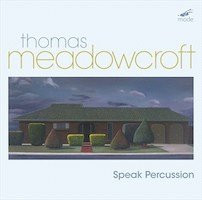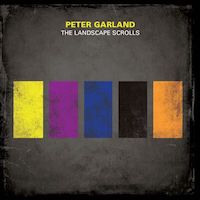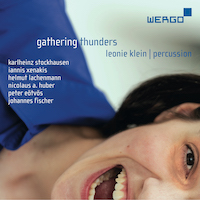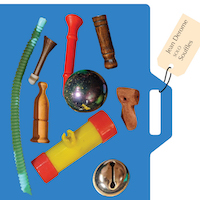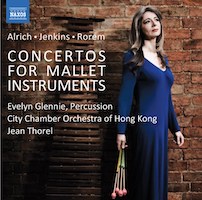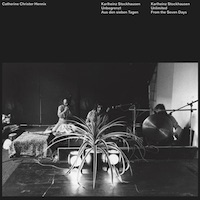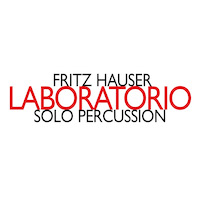Percussion Ramble with Toys
|
Grant Chu Covell [November 2021.]
Thomas MEADOWCROFT: The Great Knot (2011)1; Cradles (2013)2; Plain Moving Landfill (2003)3; Home Organs (2000)4. Thomas Meadowcroft2 (Wurlitzer), Speak Percussion: Eugene Ughetti1,2,3, Leah Scholes1,4, Matthias Schack-Arnott1,2,4, John Arcaro4, Laura Holian4, Matthew Horsley4, Peter Neville4, Eugene Ughetti4 (cond.). mode 319 (1 CD) (www.moderecords.com). It’s a mistake to approach this release of first recordings as purely centered around percussion, when in fact, tapes and electronic effects, and a musique concrète aesthetic pervade these four likeable pieces. Meadowcroft, born in Australia, but now working in Berlin, balances precision craftsmanship with casual presentation. Imagine a watchmaker who leaves windows open during a storm. In Meadowcroft’s fragile structures, players may set into motion broken toys, or trigger recordings. The Great Knot indicates a bird. We hear looped drum machines and other effects, altogether somewhat goofy and endearing. It takes confidence to create something this nimble, especially with only three players. In Cradles, a percussion duo is joined by the composer doodling on a Wurlitzer. This piece is about putting antiquated musical instruments to sleep. I don’t recognize the mellow riffs Meadowcroft is playing but do pick up a slack Satie mood. Plain Moving Landfill is a solo piece, but vast with rattling drums, the crisp grind of rubbed metal, and a collection of wheezing toys and other electronic effects. Perhaps it’s night-time in a junkyard. The sextet, Home Organs, similarly whines and meanders. The title refers to any keyboard instrument, like a Wurlitzer or Casio, but emphatically probably not a piano, which one might find in a suburban Australian household.
Peter GARLAND: The Landscape Scrolls (2010-11). John Lane (perc). Starkland ST-229 (1 CD) (www.starkland.com). Garland describes his five-movement solo percussion epic as a series of seasons depicted at different times of day. We pass from early spring (mid-day) to late spring (sunset), then summer (after dark), autumn (late) though to winter (early morning). There are animals and insects, and colors in the sky and on earth. I hear the 50-minute span more conceptually. Each movement utilizes a narrow set of instruments: 8 drums, 9 rice bowls, 3 triangles, glockenspiel, and tubular bells. The activity is continuous, in tightly flowing minimalist patterns. After the drum movement, the brighter pitched sounds create wonderful blurring. There are remarkable moments in II. Sunset when the constant activity unexpectedly introduces repeating pitches, and then when the flow is broken with small silences. The last phrase, V. Early Morning, offers nearly twenty minutes of resonating bells.
“Gathering Thunders.” Karlheinz STOCKHAUSEN: Zyklus (1959). Iannis XENAKIS: Psappha (1975). Helmut LACHENMANN: Intérieur I (1966). Nicolaus A. HUBER: Póthos (2010). Peter EÖTVÖS: Thunder from Triangel (1993). Johannes Julius FISCHER: Gathering (2018). Leonie Klein (perc). Wergo WER 7375 2 (1 CD) (www.wergo.de). Klein’s recital presents European heavyweights. Considering the first three pieces, less predictable constructions surround a rhythmic work. For Stockhausen’s “start anywhere” Zyklus, the player determines sounds and the work’s beginning and end, but not its content. In Psappha, the player choses timbres but aligns them to Xenakis’ rigid grid. Lachenmann’s Intérieur I is inscrutable, nearly 19 minutes of assorted events that sound accidental and unplanned, devoid of cause and effect. Póthos returns to a world of regularity and where events can relate to each other: the Greek title is meant to connect with Plato’s definition of longing, and how each sound prepares for the next. Eötvös’ Thunder is a timpani solo with a cadenza where Klein makes subtle reference to the rest of her program. Fischer’s three-part Gathering centers upon vibraphone (most of the other pieces avoid pitches and any clear repetition) which can be bowed (for a creepy flute sound) or prepared (the bars don’t resonate).
“Souffles.” Jean DEROME: Var. comps. (2020). Jean Derome (voice, fl, sax, perc, etc.). Ambiances Magnétiques AM 257 (1 CD) (www.ambiancesmagnetiques.com). Saxophonist Derome manically explores all varieties of whistles, toys and noisemakers across 23 exhilarating tracks. Specifics are hard to validate, but each track sounds like a single take, as Derome impulsively jumps between reeds, flutes, game calls, bells, packaging material, and all sorts of small percussion. There does not seem to be a story or theme, merely a continuous virtuosic exploration of sound producing instruments and gadgets. Birdcalls get much activity, as Derome activates more than one at a time, or finds ways to extract different pitches.
“Concertos for Mallet Instruments.” Alexis ALRICH: Marimba Concerto (2004). Karl JENKINS: La Folia (2004). Ned ROREM: Mallet Concerto (2003). Evelyn Glennie (perc). City Chamber Orchestra of Hong Kong, Jean Thorel (cond.). Naxos 8.574218 (1 CD) (www.naxos.com). Of the three pieces here, the one with the most sticking power is Rorem’s Concerto. The Alrich is a gentle minimalist-infused three-part concerto, sometimes cozying up to jazz or salsa, but otherwise conservative and impersonal. Jenkins’ variation set on the familiar theme is tasteful but anonymous. Rorem’s seven movements are carefully scripted, and Glennie must utilize vibraphone, glockenspiel, marimba and xylophone. The figurative titles suggest a program: “A Beginning,” “Another Minotaur,” “Back and Forth,” “A Xylo-Waltz,” “Let Me In,” “Tag,” and “An Ending.” Back and Forth and Let Me In could score a film noir.
Karlheinz STOCKHAUSEN: Unbegrenzt from Aus den sieben Tagen (1968; arr. Catherine Christer HENNIX). Catherine Christer Hennix, Hans Isgren (perc). Blank Forms Editions BF-011 (1 LP) (www.blankforms.org). Early on into this wonderful and uncomfortable 51:51 performance of Unbegrenzt, it becomes clear that Hennix leverages Stockhausen as a springboard to create something totally her own. Captured in February 1974, this realization of one piece (“Unlimited”) from Stockhausen’s Aus den sieben Tagen, a famously vague collection of 15 pieces (the instructions are “play a sound with the certainty that you have an infinite amount of time and space”), evolves into an enormous animal. Unlike other recordings, there are just two performers: Hennix employs various percussion and electronics effects, Isgren bows a gong, and both speak infrequently. With controlled feedback and a constant metallic whir, the result lies closer to Tudor (there may be one or two dropouts, but no matter). Contrast this performance with Zeitkratzer’s busier 5:38 which tends quickly towards something like the nocturnal portrayal of an ocean liner with guest foghorn, a valid approach, but less immersive.
Fritz HAUSER: Laboratorio (2018). Fritz Hauser (perc). hat[now]ART 216 (1 CD) (www.outhere-music.com) Setting aside Hauser’s preoccupation with architecture, Laboratorio presents six “impossible” performances offering solo percussion music for venues that do not yet exist. Hauser skillfully mixes sounds recorded near and far, tweaking amplification, etc., to create events that might be impossible to create in live performance. A thwacked temple block heard up close quietly is blended with a block recorded from far away, and the mixing desk allows layering one sound’s attack against the resonance of another. Multi-tracking allows the creation of these impossible etudes. Of course, we also get to revel in hat’s impeccable sound which makes the magic possible.
Alrich, Derome, Eötvös, Garland, Hauser, Hennix, JJ Fischer, K Jenkins, Lachenmann, Meadowcroft, NA Huber, Rorem, Stockhausen, Xenakis
[More Grant Chu Covell, Rambles]
[More
Alrich, Derome, Eötvös, Garland, Hauser, Hennix, JJ Fischer, K Jenkins, Lachenmann, Meadowcroft, NA Huber, Rorem, Stockhausen, Xenakis]
[Previous Article:
Used Bin Troll Tweets BBB.]
[Next Article:
String Theory 37: Sometimes with Piano]
|
